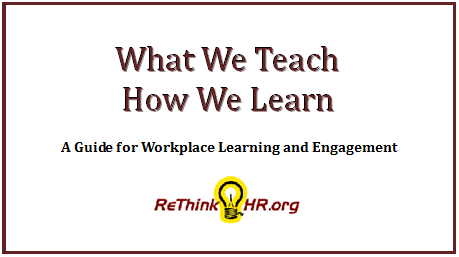Reprint from 2010 - with a few additions for 2011 #OHSHRM conference!
I’m a trainer by trade and practice…
…but I am good at a lot more. The learning aspect is just what I really love. I have been working for over 13 years. Within my career I have been in sales and marketing, Human Resources with the bulk of it being within the realm of Training Development, Business Strategy, OD. I have coached, developed, and designed programs and interactions. I have been in front of groups of one to one thousand.
I’m pretty good at it, but it never fails…
… something always happens. I have been in front of so many groups that I know my own routine. However, it never fails that before I get in front of an individual or group; for a small technical presentation to a large group of big wigs for leadership development - I always get nervous. Preparation is great, but for a few seconds between when I am introduced and that first set of words or that beginning slide, I tend to go completely blank.
It never fails. My left leg starts shaking feverishly. I get scared. But after a few moments, I regain my footing and no one can tell that I had a small heart attack… internally. Anita Baker told me “…ahh that’s because what you do means something.” I guess it does. Maybe it does.
A Few of My Own Presentation Tips
Here are some things I always try to do when I present (I’m not always great at it but I do try and perfect)
- Tell a story. I t is great if you have technical data. Facts and figures help with relevance but if you would like people to use the information you give or remember it easily, you typically have to give something more. A story from your own experience will reign true and allow the listener to paint a picture that is relevant for them.
- Make a Connection. You have to understand the audience you will be meeting so they can get you, and get what you are talking about. If you don’t make a connection then what’s the point.
- Make Eye Contact. I don’t care how dry, deep or inspiring a subject; if you don’t make eye contact with people in your audience it can come across as insincere or even egotistical. This is not always bad, but you want people to believe that you believe what you are saying.
- Humor is key. Maybe it is just me but humor helps lighten things up. It helps clear the air. The only bad thing about humor it can be like taste. Not everyone has the same as another.
- Be concise. I am constantly working at this. In this type of format: 5 minutes, 20 slides, auto-advance after 15 seconds - you have to work even harder at it. Make a point but don’t milk it too much for each idea.
- Move with a purpose. Another item that I especially have to work on in a format like this. Try not to move your hands, arms or whole body around to much. It can be distracting. Moving and standing in one place at the right moments can add meaning to what you and your topic.
- Do your research. Know what you are talking about. At the very least, prepare to answer the questions that your audience may have in their minds. Also know that anything can happen. So be ready and comfortable with not being “ready or comfortable!”
- Close with action! I think that at the end of every presentation you do in a format like this their should be a call to action. A chance for others to engage in your cause or do something on their own to move forward.
AND SOME ADDED TIPS SINCE 2010
- Room Temperature Water: While speaking during any presentation you may tend to lose your voice or your throat may become dry. Often we want to have something to drink in order to remedy this issue. What people often do is reach for a cold bottle of water or any chosen drink. However, anything cold would be a bad choice. Cold drinks tend to tighten up the throat and vocal cords, only contributing to the problem. If anything, have something to drink that is room temperature. You will thank me later!
- Everything should have a point: Your movement, your questions and even parts of the presentation you give that may not be the most important piece of your talk… they should all ultimately contribute to the overall theme. If there are items that do not contribute to your main call to action, then be careful when introducing them. You run the risk of confusing and alienating your audience. If this happens, be prepared to watch people walk out!
- Allow a place for people to take adequate notes: When you have presentation aide, whether it be PowerPoint, notes sheets or handouts, be sure there is a place for people to take notes on items that you mention and call out. Allowing places for the audience to take notes makes it easier for them.
- Use PAUSEs WELL: Long pauses can be a powerful way of inducing thought after a question to the audience. It also can allow the group time to think. Remember that as speakers we tend to think of even the shortest of pauses as an eternity. Often people are just waiting to see if others will raise a point. Be patient and allow the crowd to think if you ask them a question.
- YOU are the presentation, NOT your presentation: There are many speakers I know that are so afraid of allowing an audience access to their actual presentation. This is sad because any good presenter knows is that a great presentation does not rely on the presentation but in the presenter themselves.
These are guidelines I typically follow to make sure that I am on point as well as keep the audience on my page. Is there anything that you do to connect to your crowd?





